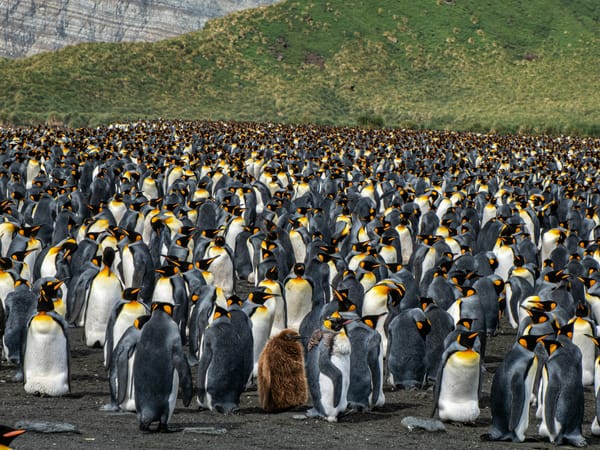How to Survive 2025 (part one)
We are all preppers now

For the last two months I’ve been careening from one sudden crisis to another in my personal life, while scrambling to meet assorted external deadlines, while watching the rapid unscheduled disassembly of the United States with nausea and grief and gut-wrenching fear.
And in between all of that, in almost every spare minute I can manage, I’ve been attempting to prepare for future disasters.
My primary coping mechanism in times of crisis is Information Acquisition. Some people respond to overwhelm with avoidance, and I sympathize with the impulse, but that has always felt like a luxury I cannot afford. When the earth starts crumbling under my feet, I get out my metaphorical stopwatch and measuring tape and try to figure out: how big is the yawning pit and how fast is it growing? And then I go read everything I can find about sinkholes, and make a plan for how to proceed.
My intention was to use that skill to not only provide Nine Lives readers with a list of likely near-future disasters, but also a comprehensive, well-researched to-do list for how to prepare for them.
But I’ve had to admit that’s just too ambitious. Disaster preparedness is not one-size-fits-all; you have to take specific circumstances into account at every juncture. And at the speed shit is breaking out there in the world (not to mention here in my household), I cannot even keep up with planning and preparing for my own little family, much less research a hundred other scenarios.
So what I’m going to do instead is explain what I have chosen to work on, and why, in hopes that will at least be a starting point for other people who want to try to be proactive instead of reactive.
Because there’s a lot, I’m splitting into two separate posts; this one is about physical preparedness and the next will be about technical.
Physical Disaster Preparedness: What and Why
The major lesson I took away from the last half of 2024 is “expect the unexpected” when it comes to natural disasters. From inland hurricanes to urban wildfires, we are in the anything goes, all bets are off, “past performance is not indicative of future results” stage of climate change. Only earthquakes and volcanoes are holding steady; everything else — wildfires, extreme heat, drought, floods, hurricanes and cyclones, tsunamis, tornadoes, blizzards, and epidemics — are all happening more intensely and more often, even in places that were previously safe.
Failures of critical infrastructure often occur as a result of natural disasters (system damage or overload) but can also occur independently, due to underfunding, understaffing, and/or poor maintenance …. or due to enemy action. Electricity, gas (both heating and vehicle fuel), internet, water, food, and medical supplies are all at risk.
Here in Mexico, infrastructure has always been kind of … iffy. I’m afraid America is about to learn what that feels like, too. Not only is Musk busily dismantling every agency that performs any kind of public service, from firefighting to weather prediction to public health, but Trump has made clear that he will happily withhold federal disaster relief from “blue” states.
Essentially, it’s all falling apart just as we can expect to need it most. In my educated assessment, we all need to prepare as much as possible for a wide variety of disasters, assuming that we have only ourselves and our personal networks to rely on, because in many cases there will be zero governmental or societal help.
While I recommend not discounting the possibility of unprecedented disasters (just ask Los Angelenos or western North Carolinians), knowing what risks are highest can be helpful for prioritization. If you live in the United States, you can look up your address on Redfin and get the First Street climate risk scores for flood, fire, heat, wind, and air.
In approximate priority order, this is what I’ve been doing to physically prepare:
Pack complete first-aid kits for home and car
I had two bad accidents this winter, less than a month apart. In both cases I would have been much better off if we’d had a good first-aid kit in our car, one with wound closures and instant chemical ice packs. Also, while we have a variety of first-aid supplies in the house, it’s a grab bag of what we’ve needed in the past (and haven’t subsequently run out of), as opposed to a deliberate stocking of specific items. As I’m stepping up my disaster preparedness, it’s occurred to me that this is … possibly unwise.
So one of the first things I started researching in January is first aid kits — what various sources recommend you have in one, and why. I’m building my own portable disaster first aid kit from scratch, in order to both save money and control the quality and specifics of the contents, and I’m updating the supplies we have stocked at home. But any first aid kit is better than none, and if you have more money than time you should definitely just pick up a prepacked kit for your car if you don’t have one. If I were buying a kit outright (and in the US) I would get one from REI, for quality control purposes. If you spend a lot of time in a workplace, I’d suggest checking on the first aid supplies available there — and if they seem poorly maintained or sub-par, stock your own.
Whether you buy or build your own kit, make sure that you have at least a week’s worth of prescription medication squirreled away. Don’t forget any medications your pets may need.
Aside from a myriad of online sources from the Red Cross on down, I’ve found the book The Ultimate Survival Medicine Guide: Emergency Preparedness for Any Disaster to be quite useful and informative. As I’m collecting supplies for the kit, I’m also doing my best to learn or remind myself how to use them. I don’t have access to an in-person first-aid class (not in my native language, anyway), but I would take one if I did.
Did you know that the worldwide standard for CPR no longer involves mouth breathing? This Radiolab episode was really enlightening.
Gather your critical documents
I recently talked to a friend who evacuated from New Orleans during Hurricane Katrina twenty years ago, and asked her: in hindsight, what do you wish you had done differently to prepare?
Her immediate answer: “I wish I’d had the important legal paperwork — birth certificates, deeds, incorporation documents, and so on — where I could grab it as we evacuated.”
“It was New Orleans; we were used to evacuating three times a year” because of flooding, she said. They had put the important papers on a high shelf and figured that was good enough. But with Katrina, the whole house went underwater, and everything was lost. “Having those documents would have saved me probably eighty hours of bureaucratic hell afterward.”
Luckily for me, consolidating our critical documents had been one of the first things I did, already mostly complete by the time I talked to my friend. When I was buying art supplies this winter, I purchased a legal-size archival acid-free storage box specifically to hold our most important documents: the deed to our house, legal copies of our wills (we each have two, one for our US assets and one for our Mexican assets), certified copies of our birth certificates and marriage license, Social Security cards, and photocopies of our passports, our Mexican Permanent Residency documentation, and so on.
That storage box lives on a closet shelf about five feet off the ground, right next to an exit, so that it’s easy to grab if we are evacuating.
Pack an emergency “go bag”
My next priority is putting together what’s often called a “go” bag or “bug out” bag, which contains most of the things that we would want to take with us if for any reason we had to evacuate our home on short notice.
I’m prepping in stages, to keep myself from becoming paralyzed with overwhelm: right now I’m putting together one 35-liter backpack with some of the most important and/or easiest to obtain supplies for our household (two adults plus pets). Once that’s done I will start working on a second bag and a more thorough supply list.
It’s proceeding slowly, so it’s possible that disaster will strike while we’re still only partially prepared. I remind myself that any progress is better than no progress, and partially prepared is better than not prepared at all.
I’ve consulted many different sources, and am strictly adhering to none of them. I definitely recommend adjusting for your particular circumstances. But as a place to start, here are the go-bag checklists from Ready.gov (archived link from December 2024) and Harvard. Also, this checklist from a random blogger struck me as both sensible and thorough.
The standard recommendation is to carry three days’ worth of food and water for your household. Water takes a lot of weight and space: for just Jak and myself, plus a cat and a dog, we’re looking at 27 liters, or about 7 gallons, of drinking water.
I can’t even imagine how, with our disabled and aging bodies, we would manage that if we had to walk somewhere.
So I have decided that, despite the upfront cost, for us it makes more sense to plan to treat and filter water on the go rather than worry about carrying all the water we might need in an evacuation scenario. For a belt-and-suspenders approach, I am going to keep both water purification tablets (which kill viruses and bacteria, but not protozoa) and a portable filtration system (which kills bacteria and protozoa, but not viruses).
The piped water here in Mexico is untreated, so we already have a complex water-filtration and pressure system for our house. A portable water filter not only gives us a way to treat water in an evacuation emergency, it gives us a backup for our house in case of extended electricity downtime or piped water failure. (We can literally walk to the largest lake in Mexico in five minutes, so on the scale of pure survival I’m more worried about contaminants than availability.)
After reading through all the relevant Reddit discussions, I’ve settled on a Sawyer Squeeze water filter with a Cnoc bag; LifeStraw is the other often-recommended option. I will keep a small short-term supply of bottled water in the backpack and rely on the filter for the rest.
There are lots of ways to handle food for a go bag. For now I’m focusing on dried fruits and nuts, and kibble for the cat and dog. Later I might try to create the ability to cook on the go — oatmeal packed in a Stasher bowl bag, for example — but I’m not up to that level of complexity yet. If we don’t use the go bag, the food and water will have to be cycled (use the old and buy new) every year.
Sometimes I find the recommendations impractical — for example, I am not going to keep a pair of shoes in the go bag at all times. Any pair of shoes that I would want to do extended walking in … is a pair of shoes I’m already using on a fairly regular basis. There are various other essentials that it doesn’t make economic sense to duplicate simply for purposes of keeping one in a go bag.
We’re not in a war zone, or in the kind of environmental danger that would require us to pick up and go in seconds; under any realistic situation I can imagine, I expect to have at least ten or fifteen minutes to gather up some things. So instead I am creating a printed list — which I will keep in the go bag — of items to pack at the last minute. That way all we have to do is go down the list and execute, rather than trying to think through everything we need in a moment of stress panic.
Researching, composing, and sourcing informative essays like this one require many, many hours of unpaid work. If you appreciate it and can afford to, please help me continue writing with a paid subscription at the Member or True Fan levels. Or you can leave a one-time, pay-what-you-can tip. Thank you for your support!
Protect your family’s health
The CDC has had serious problems for decades (read Michael Lewis’ The Premonition for some insight into what went wrong and why), but under the current regime it’s not to be trusted at all. The old CDC website has been reconstructed on European servers, but it will be permanently frozen as of January 2025, with no updates. As with most things these days, I’m getting my public health information from trusted sources outside of official channels.
Top of the list for me is Katelyn Jetelina’s epidemiology newsletter, which I’ve been reading since 2020. It’s US-focused, but still contains useful information even for those of us who don’t live there — it is how a few weeks ago I found out that Jak falls into the group of adults who need a new MMR vaccine: born in 1964, he would have gotten a less-effective vaccine as a child and is not well-protected now. We got right on that, special-ordering a dose through our GP here.
Bird flu is just a global pandemic waiting to happen; most epidemiologists believe it’s a question not of “if”, but “when”. (And there’s also a high chance of some other surprise pandemic, especially now as funding and staffing for public health craters and there’s no one left to track these things.) Kennedy’s HHS is already making existing vaccines harder to access; don’t count on any vaccine development for a novel pathogen.
Imagine another outbreak at the level of Covid-19, but instead of getting a vaccine in eighteen months, it took three or four years for one to come out of somewhere like Europe … and even then most Americans might not be able to access it. What would you do?
Number one: keep a several-month supply of quality masks on hand for the whole family. Importantly, do not rely on Amazon.com for masks. A high percentage of the masks for sale through Amazon are Chinese counterfeits. Randomized testing of Amazon-sold masks turned up some labeled as KN95s that filter as little as 12% of viruses, hardly better than no mask at all. I have been buying NIOSH-certified N95 masks (for Jak) and N99 masks (for me) from WellBefore on our trips north since 2021. We executed a full qualitative fit test (using saccharine and a nebulizer purchased specifically for the job) for both of these styles and know for a fact they aren’t leaking. Tip: masks that loop behind the head (N95) provide better fit and protection than ones that loop over the ears (KN95).
Bird flu is not only airborne like Covid-19, it also survives for longer periods on surfaces. In addition to masks I am making sure we have a stock of both rubbing alcohol and hypochlorous acid for surface disinfectant. (Here I’ve found HClO in Microdacyn spray; I don’t know what products are available in the US or elsewhere, but it’s included in some acne treatments. Read labels!)
(By the way, if you are feeding your cats raw food — as I have been for more than a decade — you’ll want to switch to a cooked diet immediately. Bird flu is incredibly lethal to felines, with a greater than 50% fatality rate, and cats are already dying from both homemade and commercial raw diets that are contaminated with bird flu. If you want more information, drop me an email.)

Plan for resilience at home
I’m also stepping up my efforts to make our home situation more resilient against short- and medium-term utility, infrastructure, and supply-chain disruptions.
I am not talking about a transition to full-on survivalist / homesteading mode — not only is that physically improbable for us, I don’t think it’s likely to be required. (I know some people think civilization will completely collapse within the next few years, but that doesn’t seem realistic to me.) The odds of a major disruption lasting days or weeks, maybe even a few months, though? — that’s actually pretty high.
This is not just because we live in Mexico, where the infrastructure is a lot crappier to begin with. The United States electric grid, for example, is under immense strain as well as constant malicious threat, and that’s only going to get worse year by year. The odds that Europe will enter into a war with Russia within the next couple of years just became distinctly non-zero. Climate change is stressing everything everywhere, and the entire world order is upended for the first time in eighty years.
Resilience often involves significant capital expenses and long-term planning, so in reality this section would be more properly titled “How to Survive After 2025.” The things that are going to help us this year are the things we’ve done over the last few — like putting in a modular HVAC system, so that we can cool any single room rather than our whole house. We switched to solar-heated water years ago, but we kept our propane water heater and rooftop storage tank for backup on cloudy winter days, and we have a (very) small propane grill on which we could cook and boil water in a power emergency. We still have an aging gasoline-powered car, so I’m looking at keeping a jerry can of stabilized gasoline on the premises in case of a fuel shortage.
Now we’re talking about putting in a cistern that could get us through a longer drought, and I’m researching portable solar generators that would give us at least a little power through a multi-day blackout. (We already get our electricity from solar panels, but they’re grid-tied. Three years ago battery backup was too expensive for us, but it’s possible that in the next few years it will be something we can manage. But never Tesla!)
In 2023 I put in three raised beds for gardening, and I try to grow a portion of our vegetables each year, but now I’m looking harder at perennials that provide food sources long-term with less time and attention than annuals. Asparagus is such a long-term project that I’d discounted it … until the regime change all but killed our chances of ever moving back to America. Now a twenty-year supply of asparagus seems pretty good, even if it will take me four years to get the first harvest. (That first year will be mostly soil preparation; we have the space but the soil is terrible. Step one is to prepare the area for a “green manure” cover crop of nitrogen-fixing cowpeas during the dry season this summer.)
I think I’ve found a Mexican source of heat-tolerant blueberry bushes, so over the next few months I’m also going to try to prepare an area with the kind of acidic soil that blueberries prefer. I’m also angling for a lemon tree, some edible passionfruit vines, some cassava plants, and a katuk tree. That’s in addition to the avocado tree, planted by a former neighbor about nine years ago, which now keeps us and our neighbor in avocados through the winter … when we can get to them before the birds, squirrels, and dogs do.
What we can’t do where we live (and frankly I don’t really want to do) is keep chickens or any other kind of livestock. We’ll never be anywhere close to self-sufficient in our food supply. But anything we can produce here will bolster us against both supply disruption and price inflation. And I’m afraid there’s going to be a lot of price inflation.
In a couple of weeks we should be able to start moving back into the 40% of our house which is currently being renovated, at which point I plan to store a couple of sealed 20-liter bottles of drinking water. Our kitchen remodel two years ago already more than quadrupled our pantry storage; I now keep between one and three months’ worth of shelf-stable supplies stocked at all times, because store availability is unreliable under even normal circumstances. We recently added a chest freezer — foremost to handle the meat supplies needed to make food for our dog and cats — but also to give us a place to keep excess garden produce (when I get so lucky — I’m still learning how to garden in a subtropical climate, and results range from “total failure” to “more than I know what to do with”). Cheese and butter freeze well too, and freezing kills weevils and prevents flour from going bad.
So those are the physical preparations I’ve been working on, in between deadlines and smaller-scale calamities. Honestly, I’ve probably forgotten something; it is pretty chaotic around here right now, what with construction and all. (Not much time for creativity lately, I’m afraid; my art projects are languishing and the short story is only a little farther along than it was two months ago.)
But it’s a start, and I hope you find it helpful. Next time I’ll explain my thoughts on technical preparations. Thanks for reading, and hang in there.




